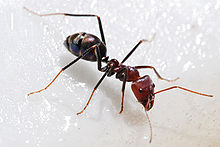- Meat ant
-
Meat ant 
Meat ant Scientific classification Kingdom: Animalia Phylum: Arthropoda Class: Insecta Order: Hymenoptera Family: Formicidae Subfamily: Dolichoderinae Tribe: Tapinomini Genus: Iridomyrmex Species: I. purpureus Binomial name Iridomyrmex purpureus
(Smith, 1858)Meat ants (Iridomyrmex purpureus), also known as meat-eater ants or gravel ants, are a species of ant belonging to the Iridomyrmex genus. They can be found throughout Australia.
Contents
Nests
 A queen meat ant burrowing a hole after her nuptial flight
A queen meat ant burrowing a hole after her nuptial flight
Meat ants live in underground nests of over 64,000 ants.[1] Many nests may be connected together into a supercolony that stretches up to 650 metres (0.4 miles). Nest holes are regularly arranged, and each leads to a separate series of branched tunnels, which typically do not connect with the tunnels from other holes. Satellite colonies are commonly formed by reproductively active daughter queens near the main nest, usually around five to ten metres away, sometimes as much as 50 metres.
The use of different parts of the nests is largely dependent on environmental factors, for example excessive shading of the main mound will stimulate the occupation of different parts of the nest or the expansion of satellite colonies. Meat ants cover their nest mounds with gravel, sand, leaf petioles, twigs, seed capsules, mollusk shells and other small items, which heat the nest quicker in the morning.[2]
Foraging
 Meat ants cooperating to devour a cicada
Meat ants cooperating to devour a cicada
 Leafhoppers excrete sugary sap that is collected by meat ants, which protect this valuable food resource
Leafhoppers excrete sugary sap that is collected by meat ants, which protect this valuable food resource
Meat ants are omnivorous scavengers that get their name from their use, by farmers, to clean carcasses.[3] Meat ants are diurnal. On hot days foraging is bimodal, with all activity ceasing during the heat of the day.
Like other Iridomyrmex species, they engage in a mutualistic relationship with certain caterpillars and butterflies of specific species which produce secretions that meat ants will feed on. In return, they protect the caterpillars from predation. Honeydew collected from hemipterous insects is the main component of the diet of most meat ant colonies. This is supplemented by scavenging for dead invertebrates.
Behaviour
Meat ants do not have dedicated soldier and worker castes like some ants. Instead they exhibit age caste polyethism, meaning that they take on different roles in the colony at different ages. Young ants care for eggs and larvae in the nest. Older ants form part of large foraging parties to exploit significant stationary food resources, such as a dead animal or a colony of hemipterous insects. Older ants undertake lone foraging across open ground, predominately collecting invertebrates and 'building material.' The oldest ants are involved in inter-colony competition.
Meat ants exhibit aggressive competitive interaction with other species of ants and are therefore a dominant component of Australian ant communities. Other species employ strategies that exploit resources or habitats not favoured by meat ants, or forage at alternate times (like the common crepuscular Camponotus species). They are aggressive towards meat ants from neighbouring colonies. Old workers engage in ritual combat along borders between colonies to establish foraging boundaries.[4] Like many other species of ant, meat ants are able to communicate with one another using chemical cues.[1]
Cane toads
Recently it has been found that meat ants are able to kill poisonous cane toads, an introduced pest, as the toxins that usually kill a cane toad's predator do not affect the meat ants.[5] The cane toad's normal response to attack is to stand still and let their toxin kill the attacker, which allows the ant to attack and eat the toad.[6]
References
- ^ a b http://australianmuseum.net.au/Meat-Ant
- ^ Coombe, Alex (2000). Nest Decoration: on the collection and use of 'building material' by the meat ant Iridomyrmex purpureus.. Adelaide University: Honours Thesis, Department of Environmental Biology.
- ^ "Meat Ant, Gravel Ant Fact File". Australian Museum. Archived from the original on 2007-03-02. http://web.archive.org/web/20070302215848/http://www.faunanet.gov.au/wos/factfile.cfm?Fact_ID=248. Retrieved 2007-04-10.
- ^ Shattuck, S. O.; Barnett N. J.. "Iridomyrmex". Australian Ants Online. Australian National Insect Collection, CSIRO Entomology. Archived from the original on December 23, 2008. http://web.archive.org/web/20081223140727/http://www.ento.csiro.au/science/ants/dolichoderinae/iridomyrmex/iridomyrmex.htm. Retrieved 2009-01-24.
- ^ Sweeney, Claire (2009-03-31). "Killer ants are weapons of mass toad destruction". London: Times Online. http://www.timesonline.co.uk/tol/news/environment/article6007268.ece. Retrieved 2009-03-31.
- ^ sjwt, sjwt. "Cane Toads". Queensland Museum. http://www.qm.qld.gov.au/features/frogs/canetoad.asp. Retrieved 2009-08-17.
External links
- Australian Ants Online page about meat ants.
Categories:- Dolichoderinae
- Hymenoptera of Australia
- Animals described in 1858
Wikimedia Foundation. 2010.
